 |
||
|
||
| ||
Part 1: Introduction, participants, configurations, terms & conditionsOur lab continues estimation of professional video accelerators. We keep on improving the testing technique and extending the number of cards. This time we have almost a final version of the 3D studio MAX which is v.4 updated to the ver.4.26. Apart from 3D MAX we have also included a synthetic test of video accelerators for OpenGL API - SpecViewPerf 6.1.2. Besides, to compare the most powerful professional accelerators with game cards we are going to test the accelerators in two games working under the OpenGL API. Since our last time we got new professional 3D accelerators, and now the list of participants includes:
The following game was set against the contestants:
As you can see, we took out the ATI RADEON 8500 card as last time it showed quite low results. CardsNVIDIA Quadro2 ProThe Reference card NVIDIA Quadro2 Pro card has an AGP x2/x4 interface, 64 MBytes DDR SDRAM located in 8 chips on the right side of the PCB.   Brief technical characteristics:
The NVIDIA Quadro2 Pro serves a base for only one card - ELSA Gloria III which is a reference card from ELSA; it comes with special software, including a driver for operation with some packets for 3D modeling - MAXTreme (it is freely available at the NVIDIA's site). NVIDIA Quadro2 MXRThe Reference card NVIDIA Quadro2 MXR card has an AGP x2/x4 interface, 32 MBytes SDR SDRAM located in 4 chips on the right side of the PCB.   Brief technical characteristics:
The NVIDIA Quadro2 MXR serves a base also for only one card - ELSA Sinergy III which is a reference card from ELSA; it comes with special software, including a driver for operation with some packets for 3D modeling - MAXTreme. NVIDIA Quadro DCCELSA Gloria DCC on the NVIDIA Quadro DCC has an AGP x2/x4 interface, 64 MBytes DDR SDRAM located in 8 chips on the right side of the PCB.   Brief technical characteristics:
The NVIDIA Quadro DCC is also used for only one card - ELSA Gloria DCC which is a reference card from ELSA; it comes with special software, including a driver for operation with some packets for 3D modeling - MAXTreme. NVIDIA Quadro4 900XGL and Quadro4 750XGLThe Quadro4 900XGL and the Quadro4 750XGL are based on the NVIDIA Quadro4 900XGL and Quadro4 700/750XGL GPU respectively, have AGP x2/x4 interface, 128 MBytes DDR SDRAM located in 8 chips on the right and back sides of the PCB. The cards differ in output connectors: the Quadro4 900XGL has two DVI and a TV-out, and the Quadro4 750XGL has a standard D-SUB, DVI and TV-out. Besides, their processors and memory work at different frequencies: 300/650 MHz for the Quadro4 900XGL (processor/memory), and 250/550 MHz for the Quadro4 750XGL. No more differences. 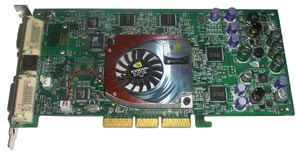 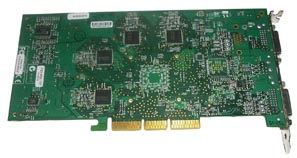 On the photo you can see the Quadro4 900XGL. Brief technical characteristics:
Go here for more detailed characteristics. ATI FireGL2The ATI FireGL2 card has an AGP x2/x4 interface, 64 MBytes DDR SDRAM located in 8 chips on the right and back sides of the PCB.  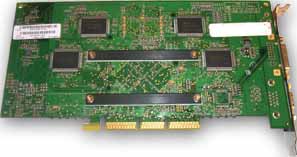 Brief technical characteristics:
This card was released by Diamond Multimedia yet before it amalgamated with S3 (today's Sonic Blue). When Sonic Blue decided to leave a video card sector its gaming and professional video cards were were sold to other companies. ATI Technologies became an owner of the FireGL family. Until now these accelerators were based on the IBM processors. And only starting from the RADEON 8500 the Canadian company announced a new line FireGL 8700/8800 based on its own GPU. That is why this card has a BIOS from S3 Corporation and a software suite from Diamond Multimedia. ATI FireGL 8800The ATI FireGL 8800 has an AGP x2/x4 interface, 128 MBytes DDR SDRAM located in 8 chips on the right and back sides of the PCB.  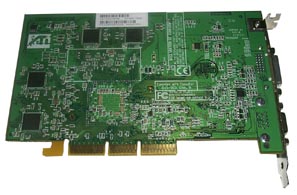 Brief technical characteristics:
Other characteristics are available here. 3DLabs Wildcat II 5000The Wildcat II 5000 has an AGP 4X-AGP Version 2.0 interface, 80 MBytes DDR SDRAM located in 10 chips on the right and back sides of the PCB.  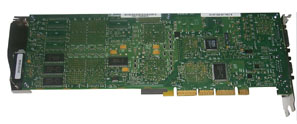 Brief technical characteristics:
This and this documents give more detailed information. The full-length ATX form-factor mean that the card is really big, and I failed to install it in any of our stands. And now the game card: NVIDIA GeForce4The Reference card NVIDIA GeForce4 4600 on the NVIDIA GeForce4 has AGP x2/x4 interface, 128 MBytes DDR SDRAM located in 4 chips on the right side and in 4 chips on the back side of the PCB.   All technical characteristics can be found in this review. Now a few words about the prices. Unfortunately, the cards differ very much in prices. For example, the Quadro2 MXR can be found at $38, though most likely you will find it at $180. And under the COMPAQ trademark this card is available at $310. The Quadro2 PRO sells at $740. The price range for the Quadro DCC is $670 - $900. The prices for the Quadro4 series has been announced by NVIDIA not so long ago, and most likely they will be reduced. NVIDIA wants $1,000 for the Quadro4 750XGL NVIDIA and $1,200 for the Quadro4 900XGL. The FireGL2 is produced under the HP trademark and sells at $870. The FireGL 8800 was announced by ATI at $1,000, though the actual price is $700. At last, the 3DLabs Wildcat II 5000 varies from $800 to $1,050. All prices are taken from companies selling the cards and from open source such as www.pricewatch.com for the end of March 2002. The only reasonable explanation I can give is that NVIDIA tries to force out old cards from the market and glut it with new models. Card settings and driversThe settings of the cards' drivers are identical for both platforms. We used the latest available driver versions. In order to avoid too many screenshots with driver settings note that we didn't changed anything in the settings after installation of the drivers except disabling of the vertical synchronization mode and anti-aliasing. Besides, if the 3D MAX optimization was available, this function was enabled. All other settings were default. ATI FireGL2The card worked with the v20.82 driver. 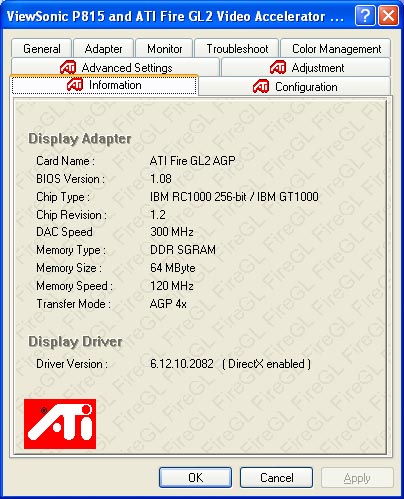 ATI FireGL 8800This card was tested with the ver.30.26 driver. 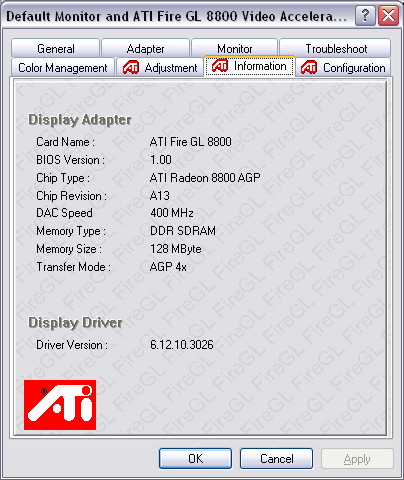  NVIDIA Quadro line and NVIDIA GeForce4The settings in the Quadro line were almost the same, that is why screenshots are shown only for the most powerful card - Quadro4 900XGL. The cards differ only in working frequencies (we didn't overclock or slow down the cards) and in AA modes, but we didn't use them either because anti-aliasing was enabled or disabled by the 3D MAX. All the cards were tested with the ver.28.32 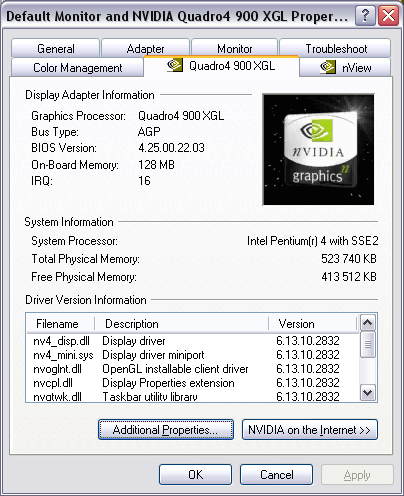 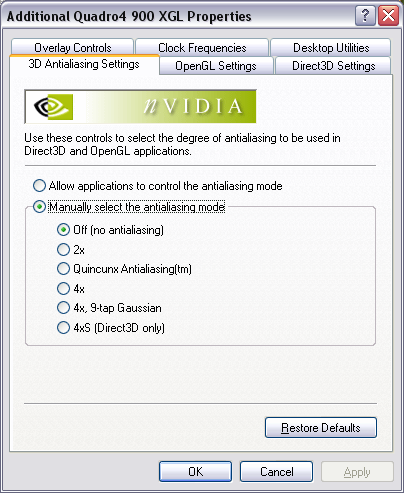  3DLabs Wildcat II 5000This card was tested with the ver.06.04.02.20  Special drivers for the 3DS MAXApart from the OpenGL for the Quadro line there was the ELSA MAXTreme v4.00.13 driver. When we started our tests it was the latest version available, but two more updates appeared in course of our testing, however, I didn't have enough time to use them. The onceover showed that some errors were corrected and a speed increased a little. I will return to these versions next time. The drivers are available at the NVIDIA's and/or ELSA's web sites and can be downloaded free. Here are MAXTreme settings:  The ATI FireGL 8800 card also has its MAXIMUM driver:  Now I'm going to tell you how we tested. [ Next part (testing technique) ]
Write a comment below. No registration needed!
|
Platform · Video · Multimedia · Mobile · Other || About us & Privacy policy · Twitter · Facebook Copyright © Byrds Research & Publishing, Ltd., 1997–2011. All rights reserved. |